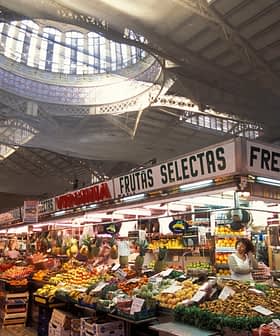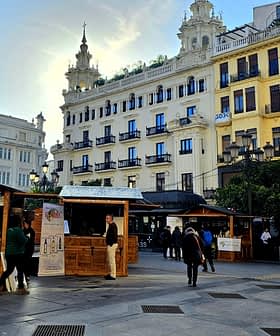Intensive Olive Farms Contribute to Desertification in Spain, Experts Warn
Researchers caution that one-fifth of Spain is at risk of desertification. Poor agricultural and land-use practices paired with historic mismanagement are largely to blame.
The specter of desertification looms across some of Spain’s most prodigious agricultural regions.
According to the government, Andalusia, the largest olive oil-producing region by a wide margin and home to most of the world’s super-high-density olive groves, is among the most at-risk territories.
Desertification is always caused by human overexploitation of a natural resource with a slow renewal in drylands, such as groundwater or natural productivity.
“The technological changes associated with the new developments in olive agriculture raise some environmental uncertainties,” Gabriel del Barrio, a researcher at the Arid Zones Experimental Station within Spain’s national agency for scientific research (CSIC) in Almeria, told Olive Oil Times.
See Also:One-Fifth of Italy at Risk of Desertification, Irrigation Experts WarnTraditional groves are similar to virgin forests in that they grow naturally in dry soil with deep roots. However, super-high-density groves tend to have shallow roots and are perpetually wet due to continuous drip irrigation.
Furthermore, traditional orchards might include centuries-old trees, while high-density groves (referred to as intensive groves in Spain) are usually made up of trees that are only a few decades old. Finally, super-high-density groves (super-intensive) include trees whose life expectancy does not exceed 14 or 16 years.
Spain is by far the largest olive oil producer in the world but still has the potential to continue rapidly increasing production as a result of the proliferation of high-density and super-high-density groves, according to Juan Vilar, a strategic consultant for the olive sector.
“Spain has enough trees to achieve, as of right now, two million tons of olive oil production,” he told Olive Oil Times in a July 2021 interview.
In the 2020/21 crop year, production reached 1.4 million tons. Both the sheer quantity and high quality of its olive oils make the country one of the world’s most relevant olive oil exporters. The vast majority of this production comes as a result of the country’s super-high-density groves.
However, the impact of this type of production on the ecosystem has yet to be fully understood, according to del Barrio.
“The consequences of these transformations to the soil biological systems, including the parasitic ones, and the ground-atmosphere exchanges of water and energy, remain almost unexplored,” del Barrio said. “An associated issue is the high irrigation requirement in areas that are naturally dry.”
In the report “Approach to the Costs of Olive Growing,” recently cited by El Mundo newspaper, the Spanish Association of Olive Growing Municipalities (AEMO) reported that the traditional olive groves represent 71 percent of all olive-dedicated territories with a total of 2.5 million hectares. Of those, 49 percent are considered mechanizable, while 22 percent have to be cared for by hand.
Yet, the costs to run and maintain traditional groves in a market dominated by high-density and super-high-density groves are so high that landowners are in the process of abandoning 130,000 hectares of groves, with another 500,000 hectares considered at risk of abandonment.
While harvesting a traditional grove might cost between €0.20 and €0.25 per kilogram of olives, for super-high-density groves that cost might be as low as €0.05 or €0.06, according to estimates from Almazaras de la Subbética, which El Mundo cited.
The researchers said that identifying the causes and effects of the soil transformation are the first steps in understanding how socio-economic and environmental factors contribute to the current trend. Desertification is the cause, and land degradation is the effect.
According to Spanish scientists, 20 percent of the country’s land is currently degraded due to the climatic and social changes that produced desertification in the past.
“This is historical degradation associated, for example, with deforestation due to the mining industries of the 19th century or to the following expropriation of land from the church at the end of the 19th century into the early 20th, land that was subsequently auctioned for profit,” del Barrio said.
According to the CSIC researchers, this type of landscape is somewhat stable and does not create environmental issues, although it needs restoration.
“A further 30 percent of the land is unproductive with a low biomass, which could be considered mild degradation,” del Barrio said.
When considering the whole country’s territory, only 30 percent of the land is not currently undergoing desertification or at risk of the phenomenon.
“Desertification is always caused by human overexploitation of a natural resource with a slow renewal in drylands, such as groundwater or natural productivity,” del Barrio said. “Normally, it is triggered in a temporal window opportunity associated with a favorable climatic oscillation, such as a rainy period, or a technological development, for instance, a more efficient groundwater extraction.”
In this scenario, “the local population tunes its efforts and economy to such an ephemeral period and becomes trapped when the exploited resource is compromised, either because the climate fluctuates to the opposite end, or because the resource does not support such extraction rate,” del Barrio added. “This is the essence of desertification and is what causes soil degradation.”
Still, researchers found that only one percent of the land is undergoing active degradation, a proportion they say resembles what is to be found in many other areas of the world, such as northeast Brazil, China and the northern Maghreb, among others.
“However, it is important to understand that the corresponding sites are being actively overexploited,” del Barrio said. “They act as black holes in the surrounding landscape, to which they export environmental disorders such as aquifer depletion, flash floods, sequestering of traditional management and more.”
Parts of Levante, the Canary Islands, southern La Mancha, the Ebro Valley, parts of Extremadura and the Sea of Olives in Andalusia are all undergoing active desertification.
Other regions, including Murcia and Huelva, are also on track to join the list if nothing changes.
Teresa Ribera, Spain’s minister for ecological transition and the demographic challenge, told the Financial Times that “Spain is the European Union country at greatest risk of desertification” and said the government would announce a new strategy to combat the phenomenon in the coming months.
One of the reasons for Ribera’s stark assessment is that land degradation caused by desertification is almost irreversible on human time scales because those areas’ ecosystems have undergone extreme simplification and lack resilience to significant changes in the environment.
Researchers are working to identify those “irreversibility thresholds,” which will enable farmers, scientists and politicians to take action before a tipping point is reached. Still, many other affected areas can be restored through reforestation or other programs that promote biodiversity.
“The chances of a site to remain degraded, recover or accept recovery, depend largely on its starting condition,” del Barrio said. “This is why we think that maps of land condition, depicting all the states of ecological maturity and not only degraded states, are a great planning tool to manage the landscape conservation and restoration.”
“Therefore, the solution is a careful monitoring approach,” he added. “It can be done using remote sensing of land surface to assess the advance or retreat of land degradation, and many international initiatives are being successful in this line.”
“In parallel, socio-economic processes substantiating desertification can be, and are being, mathematically modeled to explore long-term sustainability and resilience under changing scenarios,” del Barrio continued.
According to the researchers, the challenge is to link both approaches.
“That means to formalize feedbacks between the past, the degraded land and the present, and the desertification processes,” del Barrio said. “Such feedback is known, of course, but has to be coded into proper decision support systems, and this is what keeps a great part of the scientific community occupied.”
Other options that might come into play for olive producers come from finding “an appropriate equilibrium between extensive and intensive management, leaving unused land in between,” del Barrio said.
“For example, greenhouses in Almeria occupy a relatively small extent of land in relation with their production performance,” he added. “While such land use brings about its own issues, and it is, in fact, one of the desertification scenarios we have detected, concentrating production in these areas leaves a large hinterland in a natural or semi-natural state.”
“Therefore, we should avoid bipolarities such as traditional-good versus intensive-bad, which mislead to a simplified ecological Manichaeism,” del Barrio concluded. “Ours is a complex society, and solutions must be based on dynamic equilibria rather than on ideal scenarios.”








